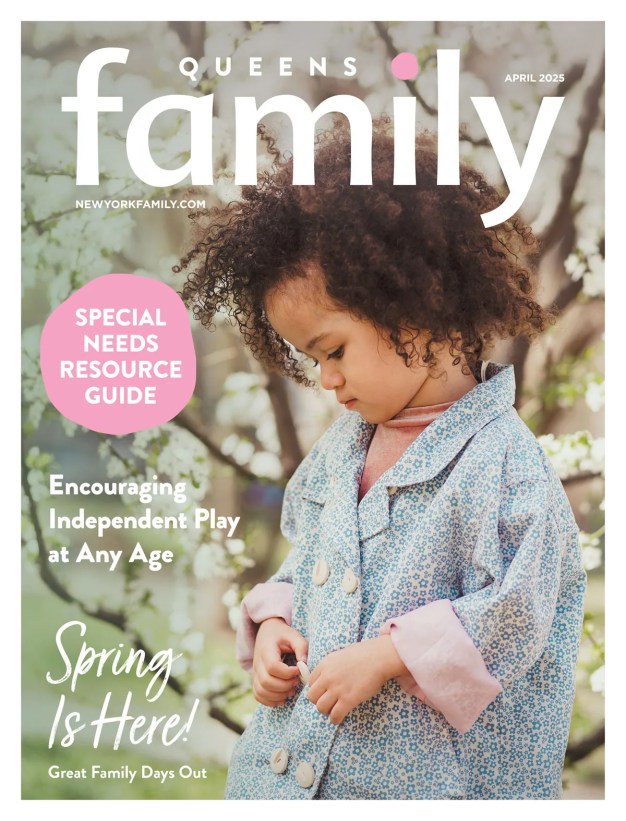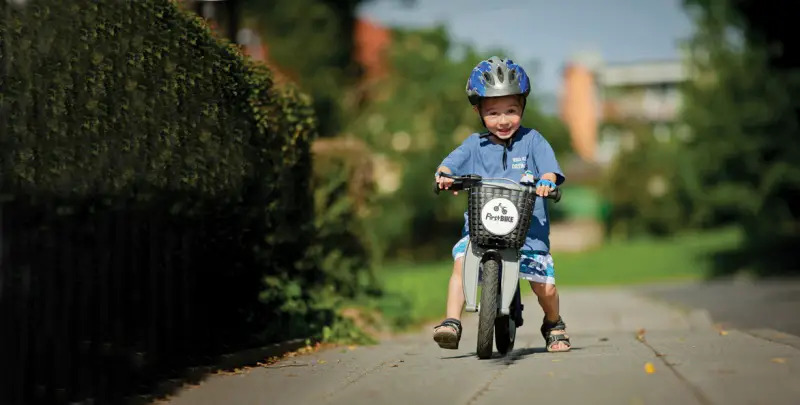Skip the tricycle and training wheels and choose a balance bike to help your child learn how to ride a bike. Here, Joseph Rumley, chief marketing officer of FirstBike, explains all you need to know about balance bikes, including how they work, tips for getting started, and answers to safety questions.
Balance Bike Benefits
What are the benefits of my child learning how to ride a bike using a balance bike, like FirstBike, compared to starting with a tricycle or a bike with training wheels?
Over the past 10 years, especially in Europe, the worldwide trend has been to replace heavy pedal bikes with training wheels, which barely develop the skill of riding a bike and are quite stressful for children and parents, with learning bikes called “balance bikes.” Although the trend is slowly catching on, it is still quite a new concept in the U.S.
Balance bikes involve not only physical activity and entertainment, but also education of even the youngest children. The bikes are great helpers when it comes to introducing basic traffic rules, using caution, and developing situational awareness.
One of the biggest advantages of the balance bike method is that children as young as 2 learn to balance on their own without explanation, coaching, or unnecessary stress. They are very proud of themselves and immediately become fond of cycling.
Unlike kids on traditional pedal bikes with training wheels, toddlers and preschoolers on balance bikes can ride for several miles at a time and run up hills—all while having fun and boosting their self-confidence. Family walks and bike trips are much longer.
In Europe, for example, when you take a walk in the park, you are surrounded by children on bikes without pedals who brilliantly balance, steer, and brake and do not torture themselves on traditional pedal bikes with training wheels. That is why these bikes are often used in preschools, gyms, amusement parks, zoos, and bike rental facilities.
After your child grows and gets stronger—around the age of 4 or 5 depending on her height and skill—she will smoothly transfer to pedal bikes without needing training wheels.
Notes on Safety
What are the safety precautions I should consider when buying a balance bike and what safety measures should be taken when my child is learning to ride a balance bike?
On balance bikes, children immediately benefit from the added security of having their feet on the ground, so it is important that the seat is easily adjustable to their height. When he sits on the bike, both feet should be firmly planted on the ground—not just his toes—with his knees slightly bent. This way, he is able to properly push off, slow down, and stabilize himself.
As your child gains more confidence and speed, a quality brake is very important. Unfortunately, many balance bikes do not possess brakes. Those that have a brake either have a brake fixed on the front wheel, which poses a risk of her flipping over when braking, or a rear “V-brake,” which poses the risk of getting her fingers, or other materials such as clothing, caught in the brake. Therefore, it is important to choose a balance bike with an enclosed rear braking system that is easily adjustable and easy to operate even by a 2- or 3-year-old.
Additionally, balance bikes with fully rotatable handlebars should be avoided. Bikes with handlebars that limit the steering angle, a “steering limiter,” help the little ones keep direction and prevent rough falls. Models with sharp edges or extruding screws should also be avoided.
Wearing a helmet on a balance bike—as on any other bike—is another must. The sooner your child gets used to it, the better. Shop for a helmet together, and let the little biker express his or her opinion. Make it a treat!
Wearing bright colors or a safety vest is also recommended, ideally with reflective elements so he is readily visible. As for shoes, balance bikes are called “run bikes” in many languages, which means that flip-flops will not do—her toes should be covered and ankles fixed.
Tips for Using a Balance Bike
What are some tips to help my child master riding a balance bike?
Keep in mind that we are talking about children between 2 and 5 years old, so the ideal place to ride a balance bike is a park or a neighborhood with little to no traffic. Begin on flat terrain and gradually upgrade to small hills. Although braking with his own feet is very intuitive, always guide him and remind him to slow down if necessary.
Around the age of 2½ to 3 years, children are able to operate a hand brake provided it is gentle enough for their little fingers. Show her how it works and motivate her to practice braking (e.g. draw a line on a street and tell her to stop on it).
When should my child transition from a balance bike to a regular pedaled bike?
The transition usually happens at age 4 or 5 when kids are stronger and taller. Pedal bikes are two to three times heavier than balance bikes and children need more power to ride them as smoothly as balance bikes.
From a balance bike, such as FirstBIKE, children learn how to balance and use a hand brake. The only skill they still need to learn is pedaling, however, at the age of 4 or 5, it is a natural transition.
What are the benefits of bike riding as a family?
There are a number of sporting activities that can engage even the youngest children. These activities generally fall into two categories: those that demand too much in terms of time and money, making them less accessible to most families, such as tennis or skiing, and those that are natural, easy, and socially open activities, which almost every family can frequently enjoy, such as cycling.
Riding a bicycle is one of the basic physical activities most children learn from a young age and further build on in the future. In the past, biking was part of the physical literacy of almost every child. In the same way we want our kids to be able to run, jump, throw a ball, or swim, we want them to learn to ride a bike.
Cycling is not only a lot of fun, it also connects people and fosters relationships—children love to explore the outdoors on bikes with their parents, grandparents, siblings, and friends. The magic of biking is that it puts the entire family in motion—little bikers often encourage adults to get up and moving, too.
Joseph Rumley is chief marketing officer of FirstBIKE, a Netherlands-based balance bike manufacturing company. FirstBIKE was developed by Ralf Coerschulte, an avid German cyclist, product designer, and father of three, with the goal to build the best balance bike for younger children, allowing them to learn to ride a bike intuitively and without stress.
Also see:
The Super Glider Bike Helps Those with Special Needs Learn to Ride





















